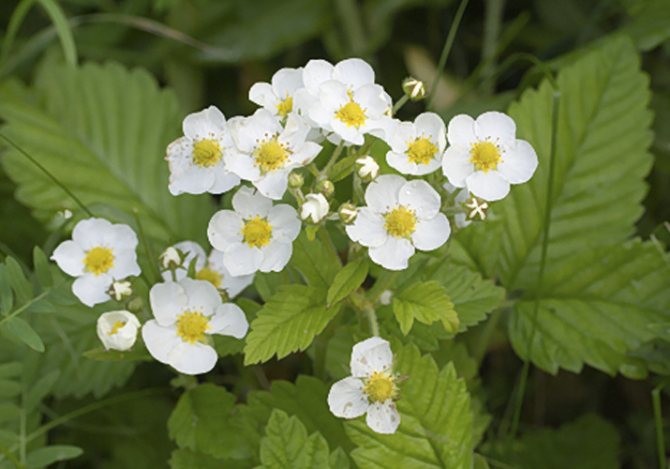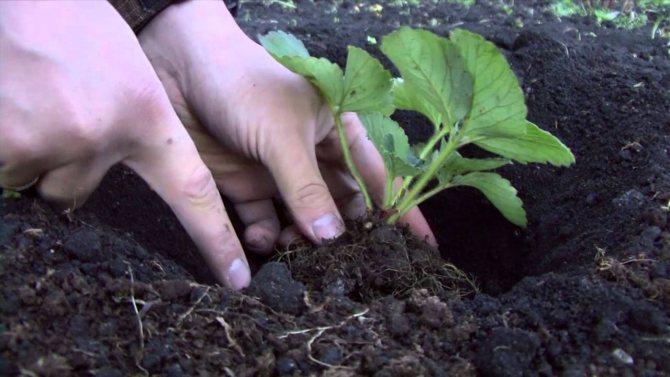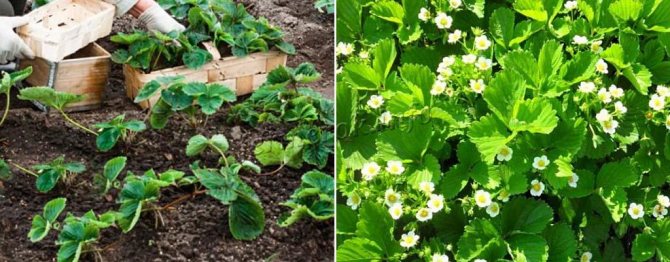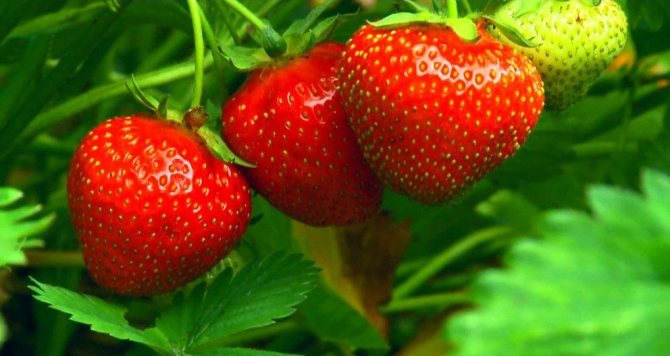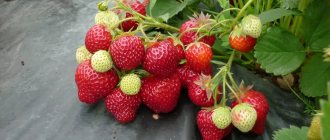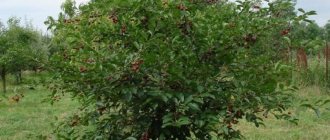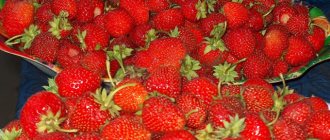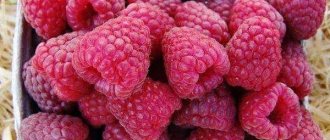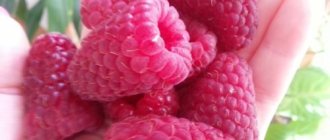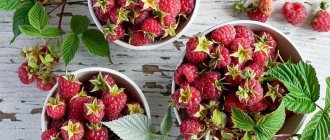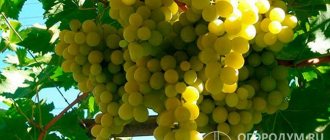One of the most successful novelties of garden strawberries of Russian selection in recent years, summer residents and professional gardeners have recognized the strawberry "Bereginya". The variety belongs to the group of late ripening and provides the duration of the collection of fresh berries during the season.

Strawberry Bereginya (pictured) has a high yield, large size and dessert taste of berries
We suggest starting your acquaintance with this promising variety with its main characteristics:
| Parameter | Characteristic |
| Culture | Strawberries (Fragaria L.) |
| Ripening terms | Late or mid-late |
| Fruiting | One-time (non-repairable), extended |
| Photoperiodic type | Short daylight hours |
| Yield | High: more than 150 c / ha; 350-600 g per bush |
| Berry mass | The first - up to 30-35 g, the main collection - 12.5-15 g |
| Fruit shape | Correct blunt-conical, no neck |
| Berry color | Orange red with glossy sheen |
| Pulp | Red, juicy, dense |
| Tasting assessment | 4.5 points (out of 5) |
| Appointment | Dessert, all types of processing |
| Flowers | Medium, white, bisexual, not twisted |
| Associative ability | High (mustache medium, pale red) |
| Sustainability | Drought resistance and heat resistance are high, winter hardiness is good. Disease and pest resistance higher than standard varieties |
| Productive life cycle | 4-7 years old |
| Recommended growing regions | Central (3) region of Russia; natural zones of Polesie, forest-steppe and steppe of Ukraine |
| Year of registration in the State Register of Ukraine | 2005 |
| Applicant and owner of the rights to distribute the variety in Ukraine | "National University of Bioresources and Nature Management of Ukraine" (Kiev) |
| Year of registration in the Federal State Budgetary Institution "State Sort Commission" | 2012 |
| Originator | FSBSI "All-Russian Institute of Selection and Technology of Horticulture and Nursery" (Moscow) |
Characteristics of the variety Bereginya
Bereginya's bush is medium-sized, semi-sprawling, heavily leafy. The leaf plates are medium in size, slightly wrinkled. The color of the leaves is light green. Leaves are glossy.
The flowers of the garden strawberry Bereginya are bisexual, which indicates self-fertility. That is, no additional pollinators are needed for this variety.
The inflorescences are compact, consisting of a large number of medium-sized white flowers.


Peduncles are strong enough, located at the level of leaves.
The bush forms a moderate amount of whiskers. Mustache of medium length, pale red color.
Bereginia's fruits are medium-sized, blunt-conical in shape. The berry has no neck. The casing is orange-red, glossy. The pulp is red, dense in structure, very juicy. The berry exudes a pleasant strawberry aroma.
Despite the high density of berries, they still have small voids inside.
Achenes are yellow, located superficially.
The berries have a sweet taste. Beregini fruits are very sweet. At the same time, there is a slight hint of sourness, which only complements the taste palette. Tasting score of Beregini berries - 4.5 points out of 5.
Composition of substances per 100 g of product:
- Sakharov - 5.7 g.
- Acids - 0.8 g.
- Vitamin C - 79 mg
Thanks to their high density, the berries are very easy to transport over long distances.It also contributes to the long-term preservation of the crop after harvest.
This variety is versatile. Beregini berries are suitable for fresh consumption, for processing into jams, preserves, compote. Also, the fruits of this garden strawberry can be frozen.
The variety is quite late in ripening. Ripening of berries begins approximately in the second decade of June. Fruiting is uniform throughout the growing season. The berries do not become smaller by the end of the season.


Berries at Bereginia are quite small, on average about 15 g. There are also specimens of 30 g.
The yield is also not the highest. From 1 hectare, you can collect 150 centners of garden strawberries. On average, about 350 g of strawberries are harvested from 1 bush, which is very small in comparison with many Dutch varieties, which give about a kilogram of berries from 1 plant.
History of creation
Bereginya's strawberry owes its birth to a group of breeders led by S.D. Aitzhanova, working at the Kokinsky support point of VSTISP, operating on the basis of the Bryansk Agricultural Academy. The parents of this variety were the famous Nightingale - also the fruit of the creation of S.D. Aitzhanova, known for its resistance to almost all the main misfortunes that pursue strawberries (frosts, winter thaws, diseases, pests), and Induka, a Dutch variety that boasts good yields. Strawberry Bereginya successfully combined the main parental qualities, which aroused great interest among both amateur gardeners and professionals.


It was zoned only in the Central Federal District, but this variety of strawberries is happily grown in the territory from the Krasnodar Territory to the Bryansk Region and even in the Urals and Siberia.
Positive and negative qualities of this variety
Domestic garden strawberries have a lot of advantages, due to which they are actively cultivated in the areas of gardeners. Among the main advantages of Beregini, it is worth highlighting:
- The variety is bisexual, which makes it self-pollinated. Bereginya does not need to plant an additional pollinator plant.
- The berries do not become smaller by the end of the season.
- The bushes form a sufficient number of whiskers, which allows strawberries to be propagated in this way.
- Bereginya is unpretentious to weather conditions and can grow in any regions of our country.
- It has a fairly strong immunity that protects it from a number of diseases.
- The berries are of high commercial quality. The berries are beautiful, sweet, easily transported over long distances.
At the same time, do not forget about the disadvantages of this variety. In general, there are not so many of them:
- Despite its strong immunity, the variety is quite susceptible to such a disease as gray rot. It should be noted right away that this disease develops in conditions of high humidity, so if you properly care for the crop, then the risk of gray rot will be minimal.
- The berries may seem small, especially to those gardeners who have grown Dutch garden strawberries.
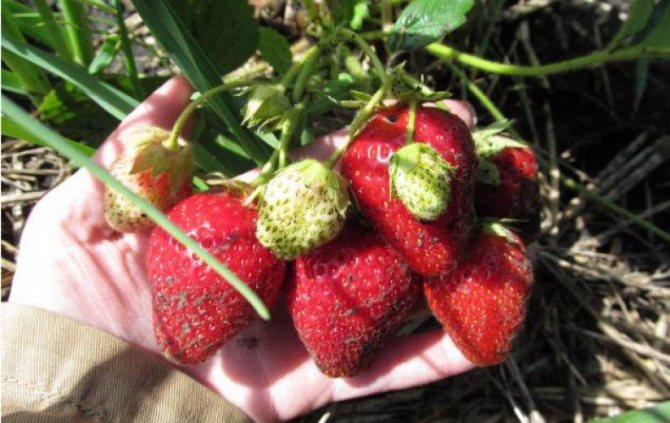

Growing
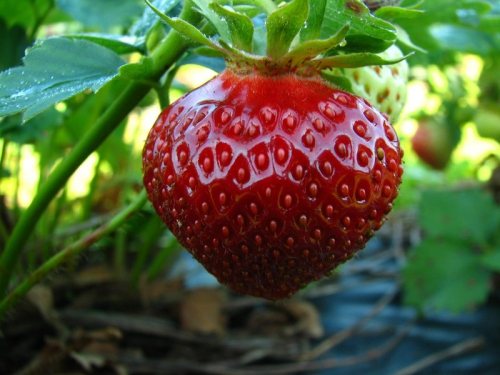

It is recommended to grow Bereginya according to the standard scheme: 50 cm between rows, 30 cm between bushes. The only weak point of the variety is gray rot, so sandy loam soil and an open sunny area will be the best conditions for it. The variety is not afraid of the sun, its berries are resistant to sunlight.
In order to plant Bereginya strawberries, you first need to prepare the soil:
- Planting should be done in the spring, fertilizers should be applied to the soil, and the land should be cleared of weeds.
- After that, planting material is harvested, which can be either purchased or prepared by its owner from the mustache abundantly growing in this variety. They take root remarkably, not inferior in yield to the mother bush.
- A very important point when planting strawberries is the correct filling of the bushes with earth. The roots must be completely submerged in the ground, and the growing point from which the leaves grow must necessarily remain at the top. If this point is buried in the ground, then the bush will not grow and simply die.
- The best prevention against disease and weeds after planting is to use artificial materials to cover the ground or mulch with straw. This will save time on weeding and keep the disease from spreading between the bushes.
After growing strawberries in a certain place for 5 years, it must be transplanted to a fresh place, otherwise a strong drop in yield will follow. This area should not be planted with strawberries for 5 years and only then can the planting be repeated. Many have 5 beds and constantly change them in turns.
Correct fit
Before starting planting work, it is necessary to select and prepare a site. The place is chosen sunny, without adjacent trees or tall crops (sunflowers, corn, etc.). The site must be clean, free of weeds.
6 months before planting strawberry seedlings, the garden is fertilized. Humus is used at the rate of 8 kg per 1 m2.
Also, it is desirable that the site be protected from northerly winds, but at the same time have good natural aeration.
The planting scheme itself is as follows:
- The first step is to pull out the landing hole. Its diameter is about 30 cm, and its depth depends on the length of the root system, but on average 15-30 cm.
- The holes are dug at a distance of 25-30 cm from each other. The distance between the holes is maintained in the region of 60-70 cm. Such a distance will allow you to easily care for the crop and harvest without problems.
- After the holes are dug, they are watered abundantly with water. About 1000 ml of water is consumed per hole.
- When the water in the holes is absorbed, seedlings are placed in them. Seedlings must be placed in the hole strictly vertically, while gently straightening the root system.
- After the seedling is placed in the hole, it is sprinkled with soil and tamped. At the end of planting, the plants are watered again. The consumption is the same, about 1 liter of water per 1 bush.
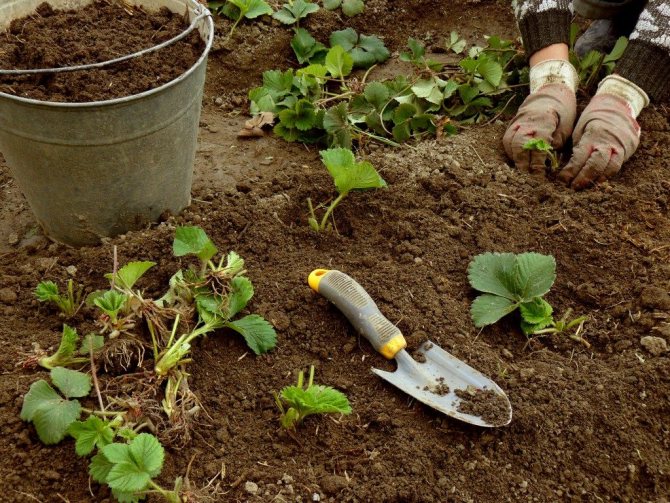

How to choose good strawberry seedlings
Before planting Bereginya strawberries on your site, you must choose the right planting material:
- there should be at least 2-3 young leaves on the seedlings;
- good seedlings have healthy shiny and green leaves;
- the root collar must be free of spots, rot and have a diameter of at least 0.5 cm;
- the horn must be at least 0.7-0.8 cm thick: the thicker it is, the better the harvest will be;
- seedlings with an open root system should have fibrous roots, at least 7 cm long;
- seedlings sold in a peat pot must completely master the soil in it: the roots must go out through the walls;
- bushes should not be lethargic.
Important! Do not buy bushes with pale leaves - this is a sign of late blight. Also discard seedlings with shriveled young leaves - they indicate a strawberry mite attack.
It is best to buy planting material in certified nurseries. If this is not possible, then it is worth giving preference to trusted sellers who have been selling seedlings for several years and value their reputation.
Care rules
Despite the fact that garden strawberries seem to be a difficult crop, it is quite simple to care for them. The basis of care is timely watering and feeding the plant. Also, if the variety has a tendency to strong formation, you will need to remove the mustache.
We also recommend reading: Description of the Eliane strawberry variety
Top dressing
Fertilize strawberries 3 times per season:
- In the first year after planting seedlings, the culture does not need fertilizers.Starting from the second year of life, the plant begins to actively feed. The first feeding is carried out immediately after the end of the cold weather, in early spring. At this time, it is advisable to feed garden strawberries with nitroammophos (the solution is prepared as follows: 1 tablespoon of the substance is diluted in a bucket of water).
- During the formation of ovaries, the plant needs phosphorus-potassium fertilizers.
- In the fall, after harvesting, strawberries are fed with organic matter. The plant needs it in order to saturate it with nutrients and prepare it for winter sleep.
Watering
Lack of moisture can lead to a deterioration of the immune system of the plant or its complete death. Therefore, it is always necessary to water garden strawberries. But at the same time, do not forget that the variety is highly susceptible to gray rot, which, by the way, develops in conditions of high humidity, therefore, strawberries are watered sparingly, without creating a swampy area around.
Usually Bereginya is watered once a week. Such irrigation is quite enough to ensure the maximum productivity of the crop.
In dry periods, the number of irrigations is increased to 2 per week, sometimes up to 3.
If the drip irrigation system is not used, then it is advisable to water the strawberries in the morning and evening, when the sun is in an inactive phase and cannot burn the leaves.
Water the garden strawberries with settled warm water. It is impossible to water from a well, as cold water can lead to the development of various diseases.
Reproduction
For propagation of this variety, you can use the purchased material, but it is still recommended to use your young plants (seedlings).
Even at the stage of harvesting, it is necessary make notes on plants that have the following parameters:
- the bush should have healthy and approximately equal-sized fruits;
- leaves should be large, succulent and uniform in color.
Already in the middle of summer (July), you can plant a new ridge with socketsthat appeared on the whiskers of the selected bushes.
Note! It is recommended to arrange the strawberry beds from north to south. This will provide excellent sunlight exposure.
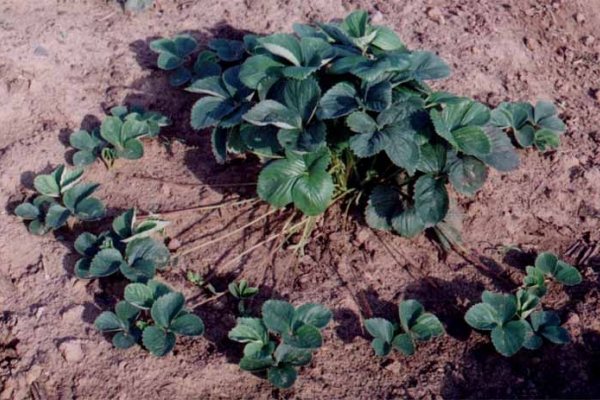

In mid-July, you can plant a new ridge with rosettes that have appeared on the whiskers of selected bushes
Pests and diseases
The variety thrives in various climatic conditions of cultivation. It has a fairly high frost resistance and heat resistance.
According to many experts, Bereginya has higher immunity rates than most varieties of garden strawberries (tests were carried out in 2006-2008). The variety is resistant to diseases such as verticillium. Also, he is rarely affected by various fungal diseases. As for parasites, Bereginya is very rarely invaded by a common insect - a spider mite.
At the same time, it is necessary to take into account the fact that garden strawberries show good immunity only in good growing conditions, so you need to provide them with proper care.
Varietal features
The strawberry variety "Bereginya" has some peculiarities.
The variety is characterized by high winter hardiness, so it can be grown both in the south and in the northern territories. Strawberries are also resistant to strawberry mites, mites, verticillosis, and other fungal diseases that affect strawberry leaves.
The considered variety is of medium late ripening. The crop can be harvested after June 20.
"Bereginya" is notable for its good yield - about 15 tons of strawberries can be obtained from 1 hectare.
Due to their dense structure, the berries can be transported over long distances, they are stored for a relatively long time.
Strawberries contain a lot of vitamin C, so they are recommended to be eaten fresh.In addition, any homemade preparations can be made from berries: preserves, jams, compotes. Strawberries make delicious fruit salads and pies. Berries also serve as a very nice decoration for cakes.
Gardeners reviews
Valentina Yurievna, Kiev, 52 years old.
I liked the variety Bereginya. Garden strawberries of this variety have a wide conical shape, slightly flattened. The pulp is tender, without fibers. The berries are large. The leaves have never hurt anything, although I have been growing Bereginya for the 5th year already. Of the shortcomings, I would note a weak resistance to moisture. When it rains, the berries rot, not all of course, but some rot.
Viktor Dmitrievich, Ryazan, 42 years old.
Bereginya grew up in 2012, showed itself as an ordinary variety of garden strawberries, at approximately the same level as the Tsarina. The first berries of 35 g somewhere, then very much smaller, although in the description I found that they should not be smaller. The yield is high, despite the small size of the berries. Immunity is also good, for the two seasons that I cultivated it, I did not grab any sore. But still, if you compare with the Tsarina, then the Tsarina will be better, as for me.
A few more secrets of professionals
A number of secrets will help to avoid additional contamination of strawberries with a number of pests that manage to settle on Beregina even after pretreatment of strawberries:
- In the process of planting a variety, as additional care, gardeners recommend additional measures for soil cultivation.
- The more often shrubs are transplanted to another site, the better. But you shouldn't get carried away either.
- To prevent the spread of ground pests on plantations, the berry should be treated from weeds in a timely manner.
- The best planting site for the Bereginya variety is considered to be the area where plants grow that repel garden pests. For example, gardeners include lupine flowers among such plants.
Knowing these secrets, you can significantly simplify the process of caring for the berry and not be afraid of additional infection with unwanted bacteria.
Sustainability
The variety is adapted to various unfavorable weather and climatic conditions, has ecological plasticity: medium winter hardiness, high resistance to heat and drought.
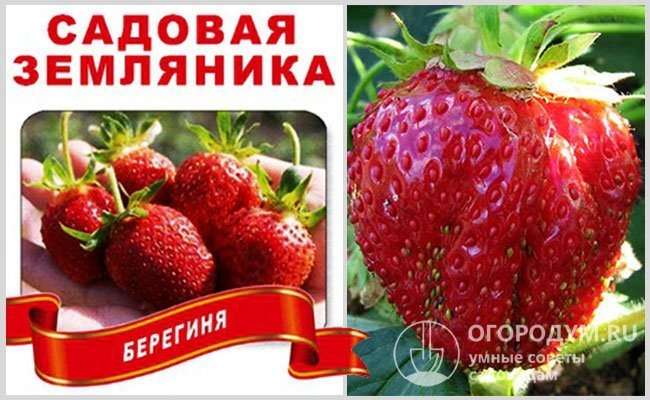

Planting material of the variety is produced and sold by many domestic nurseries and agricultural firms.
Experts note the high (higher than that of standard varieties) resistance of "Bereginia" to fungal diseases of the leaves, verticillium wilt and spider mites. According to the author, it is better to grow the variety in more southern regions where there is no gray rot. However, it should be borne in mind that in hot climates, plants are more demanding for watering, and drip irrigation is considered optimal for them.
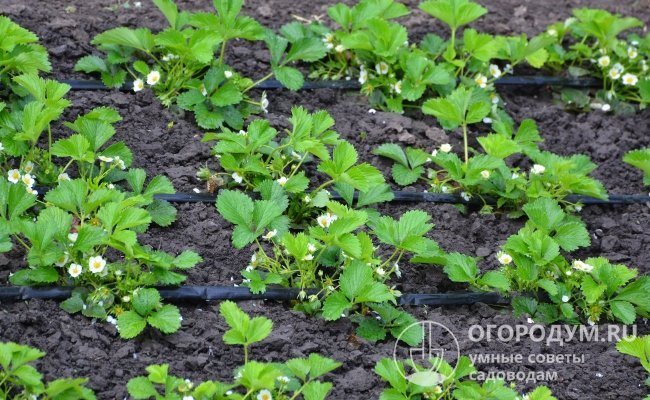

The presence of drip irrigation is considered a prerequisite for cultivating the variety in the southern regions.
In general, the variety is unpretentious in care and responds well to standard agrotechnical measures: regular watering and complex fertilizing, preventive treatments against diseases and pests, loosening or mulching of the soil. Since the plants give a large number of whiskers, the plantings thicken rather quickly and must be cleaned of excess shoots, damaged leaves, and weeds.

